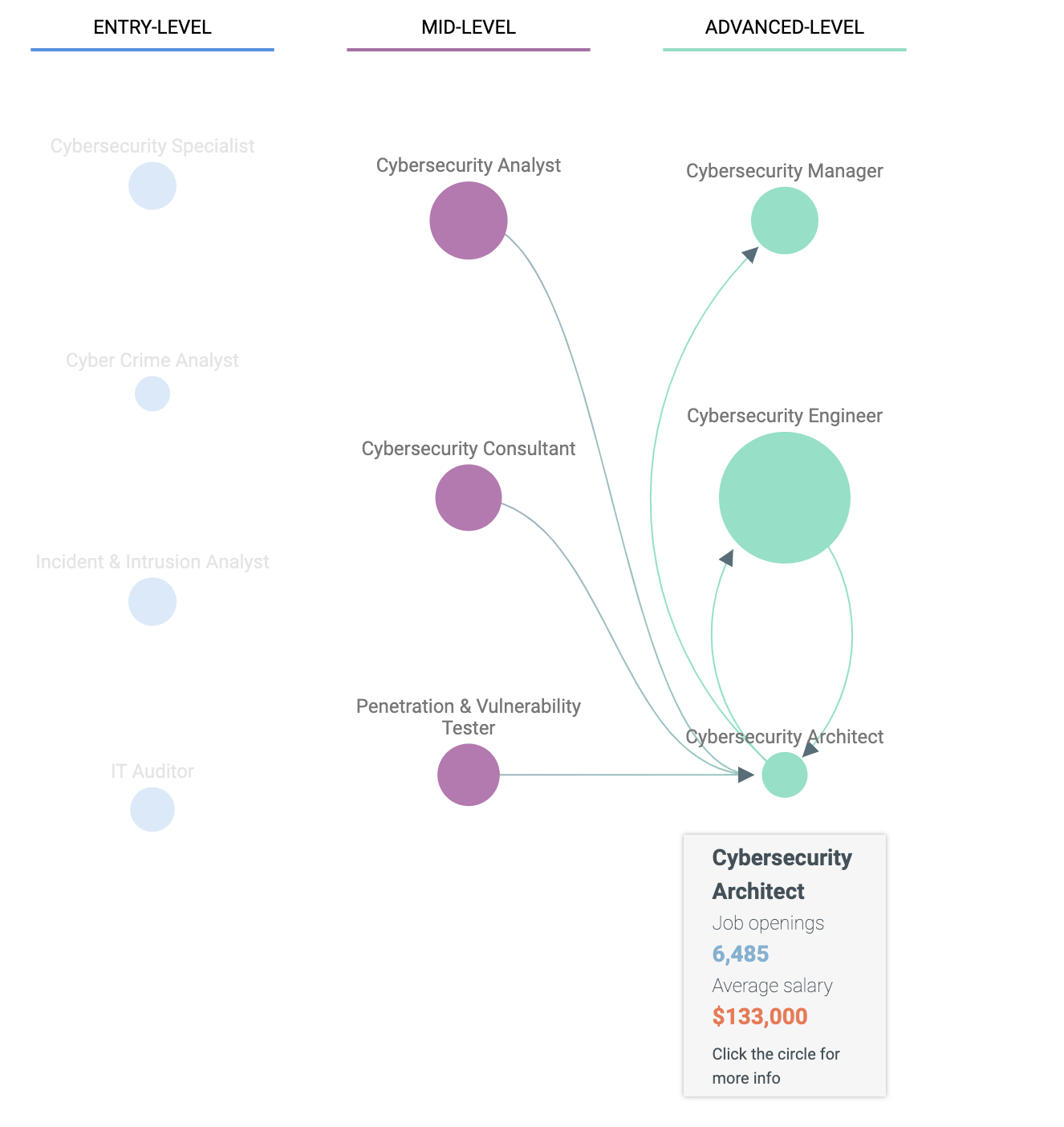Free Cybersecurity Course
Enter the cybersecurity field with our free introductory course. Learn the basics and build a strong foundation.
Cybersecurity continues to be a top priority for business leaders, especially as entire workplaces have shifted to a fully digital work environment. Cybercrime remains a big concern for industries of all kinds. A report from Accenture found that 68% of business leaders say their cybersecurity risks are increasing. What’s more, the cybersecurity market is expected to reach $325.25 billion by 2026.
More organizations are thus investing in cybersecurity roles to ensure that they’re implementing the latest innovations and best practices to keep their systems and information secure. Cyber attacks may look like phishing attempts, malware, DDoS attacks, and more. And hackers are becoming more sophisticated as they respond to stronger security methods. This is where the cybersecurity architect steps in.
So, what is a cybersecurity architect, and what does this career path look like? Here’s everything you need to know about becoming a cybersecurity architect.
What Is a Cybersecurity Architect?

Today’s organizations need a dedicated plan to prevent and ward off cyber attacks. Many now create a holistic and complex cybersecurity architecture comprised of applications, software, and other tools. A cybersecurity architect is a person who oversees these security blueprints, ensuring that all key considerations are addressed.
For example, just like a building architect creates a blueprint for physical structures, cybersecurity architects plan out each aspect of a security system, making adjustments based on industry trends and company priorities.
Other terms frequently used for this role include:
- Security architect
- Senior security architect
- IT security architect
Architects aren’t just knowledgeable and experienced in the cyber world. They also need to be effective managers and problem-solvers, since these roles are usually senior-level.
The soft skills required include communication, creativity, leadership, critical thinking, solutions-oriented, and more. These skills are in addition to having a strong background in information technology and security.
What Does a Cybersecurity Architect Do?

Strategy, design, trial-and-error, and implementation are all components of a cybersecurity architect role. These experts oversee the entire infrastructure of network and system security. Key responsibilities may include:
- Creating and collaborating on cybersecurity plans for the entire organization
- Developing outlines for a company’s most pressing security needs
- Anticipating potential data security risks and learning of the latest tactics hackers are using to infiltrate systems
- Updating current security methods with new technologies
- Managing other IT professionals
- Creating individual security plans for each IT project
- Conducting risk analyses and security assessments
- Uncovering any gaps in the design of cybersecurity architecture
- Creating and implementing cybersecurity policies and best practices
- Ensuring all security policies and procedures are being followed
- Educating staff across the organization on best practices and the importance of cybersecurity
- Communicating top cybersecurity priorities and budgets to company leaders
This list is not comprehensive. Plus, specific tasks will vary based on the size of the organization and the types of networks and systems used to keep business running. For example, an organization may not need a cybersecurity architect to communicate with the rest of the company. Alternatively, another business leader may take on that responsibility after being briefed by IT.
But, one thing is clear: the cybersecurity architect is a master at creating a cybersecurity plan. They ensure that it’s followed while updating the infrastructure as needed.
Get To Know Other Cybersecurity Students
Jose Mendoza
Cyber Security Career Track Student at Springboard
Ed Burke
Cyber Security Career Track Student at Springboard
Karen Peterson
Compliance Advisory Associate at Coalfire
Cybersecurity Architect Salary and Growth Opportunities
The role of a cybersecurity architect is advanced, so these professionals generally have a lot of experience under their belts. They may have started in a role like a cybersecurity specialist, a cybercrime analyst, or an IT auditor, which are usually entry-level positions.
Mid-level jobs include a cybersecurity analyst or consultant. Advanced titles around the same level as an architect are cybersecurity manager and engineer.
These higher-level roles may report to the company’s chief technology officer (CTO), chief security officer (CSO), or chief information security officer (CISO).
According to data from Cyberseek, the average salary for a cybersecurity architect is $133,000. So, it is a great opportunity to have a lucrative career. And it makes sense—cybersecurity architects play a crucial role in ensuring that a company’s sensitive information is protected from attackers and malicious outsiders with a complex security system design.

Cybersecurity jobs are also expected to grow. According to the Bureau of Labor Statistics, information security analyst jobs will grow 31% between 2019 and 2029. This is significantly faster than the average job growth. Computer network architects will see 5% growth over the same period.
These roles are becoming more important as organizations become increasingly dependent upon digital infrastructures to conduct business.
How to Become a Cybersecurity Architect in 6 Steps

Cybersecurity architects play a unique but crucial role in ensuring that businesses can protect themselves from cybercriminals. If this sounds like the career path for you, there are a few important steps to take to get started. Remember that the kind of knowledge, experience, and skills required to perform this job takes time to accumulate.
Here are six steps to become a cybersecurity architect:
-
Consider a College Degree
-
Get Certified
-
Work in the Field
-
Make Connections
-
Know the Core Skills You Need
-
Prepare for Your Job Search
1. Consider a College Degree
More often than not, a cybersecurity architect has a college degree. 84% of cybersecurity job posts require a bachelor’s degree, and many prefer a graduate degree. Consider a degree in one of these areas:
- Computer science
- Information technology
- Business information systems
Master’s degrees are where you can really focus on cybersecurity, so consider going that route or at least getting a graduate degree in one of the IT fields.
2. Get Certified
Bringing additional certifications to the table can help you stand out and give you a broader set of skills to use in the role. Common certifications for cybersecurity architects include:
- Certified Information Systems Auditor (CISA)
- Certified Ethical Hacker (CEH)
- CompTIA Security+
- Certified Information Systems Security Professional–Information Systems Security Architecture Professional (CISSP-ISSAP)
- Certified Information Security Manager (CISM)
- GCIA/GSEC/GCIH (GIAC)
3. Work in the Field
Building up the right experience is crucial to getting a higher-level position in cybersecurity. Your goal should be to work as closely with cybersecurity as you can in your entry-level and mid-level positions. Consider roles like:
- Security administrator
- Security engineer
- Analyst
- Cybersecurity specialist
- Network administrator
- Security consultant
- Penetration and vulnerability tester
- System administrator
These roles will teach you a lot about the way a company’s systems work, paving your way to a career as a cybersecurity architect. When your goal is to move up in the future, show your managers that you take initiative and are dedicated and reliable workers.
4. Make Connections
Anyone trying to scale up in their field can benefit from networking. Make sure you form relationships with your managers and coworkers so you can support one another in your career pursuits. Let them know what your long-term goals are so they can keep you in mind for any opportunities that come up.
Consider a mentorship in cybersecurity with someone who has a job that you want someday. Join groups and associations where you can connect with other cybersecurity professionals, whether in your area or online.
5. Know the Core Skills You Need

While there are lots of competencies that go into this important role, a few stand out as musts that hiring managers look for. These are:
- Information security. You need to know the latest technologies, best practices, and policies that go into a sound security structure.
- Cryptography. Encryption technology and cryptography are wise skills for architects to master. Keeping data safe from unauthorized actors is crucial in creating a successful cybersecurity plan for a company.
- Project management. Because an architect is a more senior role, they must have excellent problem-solving and project management skills. They’ll probably be managing lots of projects and people at once, so comfort with multitasking is a plus.
- Network security. A security architecture is made up of company networks that need to be secured. Architects should know how networks operate and the best ways to keep them safe, like using firewalls or virtual private networks (VPNs).
6. Prepare for Your Job Search
The last step is mastering the application and interview process to get hired. You need to leverage all of the above experience and skill-building you’ve spent so long working toward. Make sure your resume reflects specific tasks you’ve taken on at relevant roles, and mention all of your education and certifications.
Be prepared to discuss specific projects in your interviews and how you have faced challenges. For example, in a past role maybe you led an initiative to implement multi-factor authentication across a company. Discuss roadblocks, how you worked with a team and your responsibilities in ensuring that everything went smoothly.
Since you’re here…
Breaking into cybersecurity doesn’t take a Trojan Horse. Our Cybersecurity Bootcamp lasts just six months, and we’re ready to help you land a job after graduation or your money back. There’s urgent need in this field, so we’re beaming out tons of freebies to entice you, like this email course on certifications and our guide to becoming a software security analyst. Join in—there are plenty of jobs to go around!






